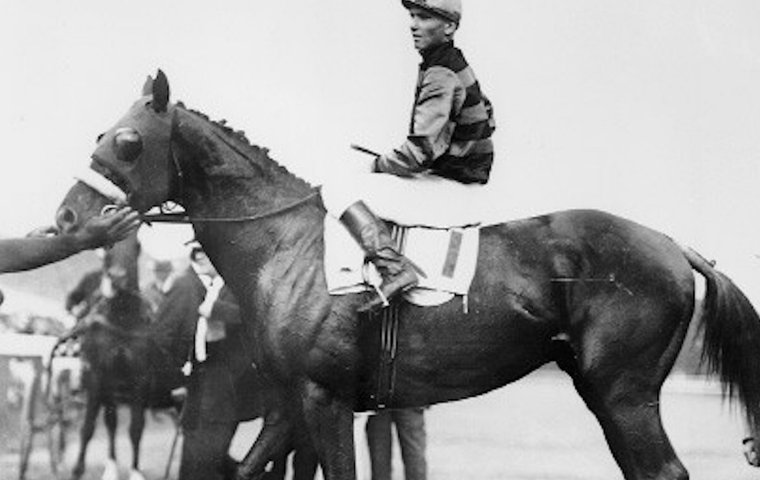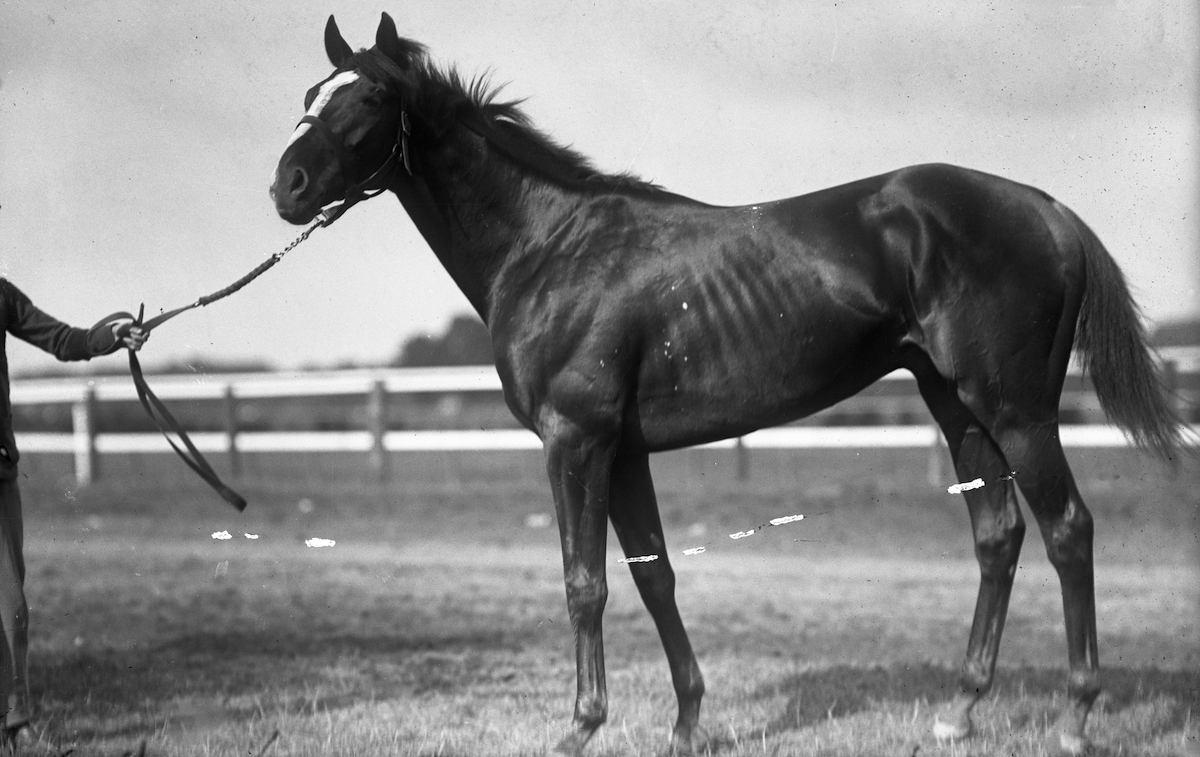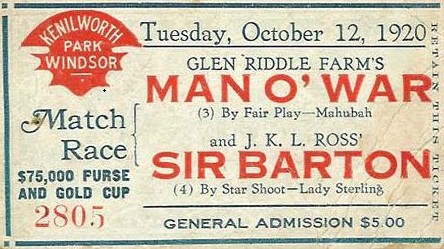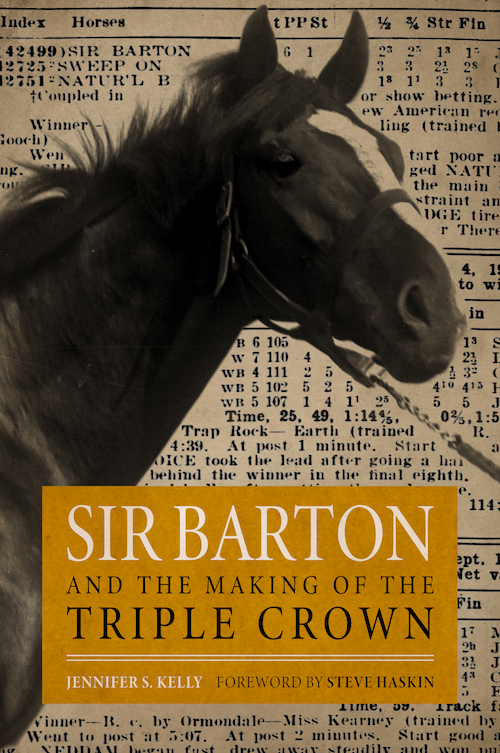
In 1919, Sir Barton won the Kentucky Derby, Preakness and Belmont Stakes to claim America’s first Triple Crown – a decade before the concept even existed. Jennifer S. Kelly recalls his victory in America’s signature race.
Trained by H. Guy Bedwell and owned by Canadian businessman Jack Ross, a volunteer naval commander, Sir Barton was to go down in racing folklore as the first horse to sweep what was to become the Triple Crown.
In Sir Barton and the Making of the Triple Crown, Jennifer S. Kelly focusses on the colt’s pioneering impact, revealing the legacy of his seminal contributions to Thoroughbred history more than 100 years after his seminal achievement.
In this extract, she recounts how Sir Barton – winless in six previous outings and having suffered from a near-fatal illness – landed his first career success with a surprise victory on his seasonal debut in in the Kentucky Derby under jockey Johnny Loftus.
 Despite the weather, chilly for early May, Kentucky’s holiday had attracted a crowd of 50,000 to Churchill Downs. The field of 12 – five geldings, six colts, and one filly – paraded to the post for the Kentucky Derby, the fifth race on the day’s card.
Despite the weather, chilly for early May, Kentucky’s holiday had attracted a crowd of 50,000 to Churchill Downs. The field of 12 – five geldings, six colts, and one filly – paraded to the post for the Kentucky Derby, the fifth race on the day’s card.
Included among that dozen were the two horses who had competed for the juvenile crown in 1918 and other notables such as Vindex and Be Frank, starters from prestigious owners H. P. Whitney, Willis Sharpe Kilmer, and W. F. Polson.
Between these 12 horses and victory lay ten furlongs, a distance that each had yet to travel in their short careers. The heavy track, the Kentucky dirt still laden with days’ worth of rain, sloshed under their feet as they strode to the starting barrier at the top of the Churchill Downs stretch.
Sir Barton and Johnny Loftus took their place on the rail, post position one, while Billy Kelly and Earl Sande stood on the outside, in post position 11. At 5.10pm, the crowd watched the horses in their positions at the barrier, “some of the horses excited and alert, others staid and controlled, ready to be turned loose when the word is given.”
After four minutes, starter A. B. Dade sent the field away, the gathered multitude gasping, “They’re off!,” as the field took stride and passed the grandstand for the first time.
Sir Barton broke cleanly from the rail and got to the front about six strides in, the other horses falling in line behind him. In order to avoid running in the muddy aftermath of other horses, Loftus needed to hustle the colt to the front immediately; by the first quarter, Eternal was second, two lengths behind Sir Barton, and Billy Kelly was third, just behind Eternal.
At the half-mile mark, Schuttinger pushed Eternal to move within half a length of Sir Barton, but Loftus shook up Sir Barton and the colt pulled away, Eternal fading from the effort of trying to keep up.
Eternal fell back through the field, giving Sande and Billy Kelly, now in second, a chance to catch and then pass the gelding’s stablemate. As the field swept into the stretch, the 1919 Kentucky Derby came down to its final furlongs, the two horses in orange and black leading the way.
If Bedwell or anyone else in the Ross party expected the front-running son of Star Shoot to fade at this point in the race, nine furlongs in and one more to go, Sir Barton, still under restraint, proved them wrong. Neither slowing nor fading, he went faster as the race went on, running his mile in 1:41⅘.
With Eternal beaten, fading to the back of the pack of 12, Billy Kelly did his best to catch up; Loftus stalled on Sir Barton, looking around to see how close the gelding was. When he did not see Billy Kelly, Loftus tapped his mount with the whip, and Sir Barton responded as if this were the race’s start rather than its end.
His lead grew larger in the stretch, and he hit the wire five lengths in front of his stablemate. It was the first time two horses from the same stable had finished one–two in the Kentucky Derby. Sir Barton chose the Kentucky Derby, one of the country’s most famous races, to break his maiden, and he did it in sensational style, despite the dreary weather and the heavy track.
Although Sir Barton may have shocked everyone with the decisive way he took the Derby, H. G. Bedwell did not betray any surprise at the colt’s win, despite the fact that Sir Barton had beaten Bedwell’s own admitted favorite, Billy Kelly.
The only thing that dismayed the trainer was that the Derby win meant that Sir Barton lost his maiden advantage in the Preakness Stakes, which would be run four days later in Baltimore. The ‘hard-luck’ colt who had been winless in six starts to that point now brought home $20,825 for his owner; Ross also got the second-place horse’s share of $2,500.
Despite Billy Kelly’s second-place finish, Commander Ross won the wager with Arnold Rothstein: Eternal finished tenth, well behind his rival. Not only did the commander come away with nearly $24,000 in purse money, but he also won $50,000 from Rothstein, more than double the purse money Churchill Downs offered for the Derby.
Sir Barton’s win also validated the hunches of Sam McMeekin, who trumpeted his prediction in a reprinted paragraph from his May 10 article in the May 11 edition of the Louisville Courier-Journal, trumpeting, “I TOLD YOU SO!” in his write-up of the victory.
No doubt Cal Shilling, the lone champion of the chestnut colt in the colt’s own stable, was feeling validated as well. Their time to celebrate was short, however, as H. G. Bedwell turned the stable’s attention away from the twin spires of Churchill Downs and toward the familiar sights of Maryland and Pimlico.
The Preakness Stakes was scheduled for Wednesday, May 14, and the Maryland-based Ross Stable was eager to bring its horses back home to run in Pimlico’s important stakes races.
Duplicating War Cloud’s route from the previous year, Bedwell declared Sir Barton for the Preakness Stakes, only four days hence. In the wee hours of May 11, long before fans could venture to Churchill Downs to get a glimpse of the newly minted Derby winner, Sir Barton and Billy Kelly boarded a train bound for Baltimore, back to Maryland and a few miles closer to history.
 Sir Barton and the Making of the Triple Crown by Jennifer S. Kelly is published by the University Press of Kentucky. A new paperback edition with a foreword by Steve Haskin is due to be released in May 2023; pre-order for $19.95 here at the Kentuckypress.com website
Sir Barton and the Making of the Triple Crown by Jennifer S. Kelly is published by the University Press of Kentucky. A new paperback edition with a foreword by Steve Haskin is due to be released in May 2023; pre-order for $19.95 here at the Kentuckypress.com website
• Visit the Kentucky Derby website
‘He could not overcome one thing: he was Black’ – the extraordinary life of Jimmy Winkfield
Why the long and winding road should be short and straight – Steve Dennis on the Kentucky Derby
Kentucky Derby: who are the early front-runners for America’s most famous race?
View the latest TRC Global Rankings for horses / jockeys / trainers / sires


